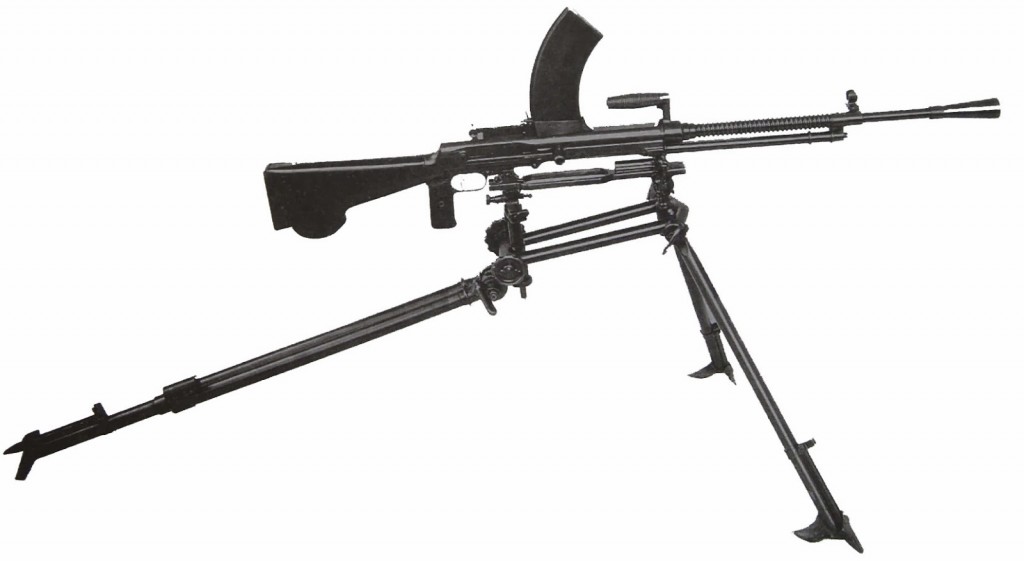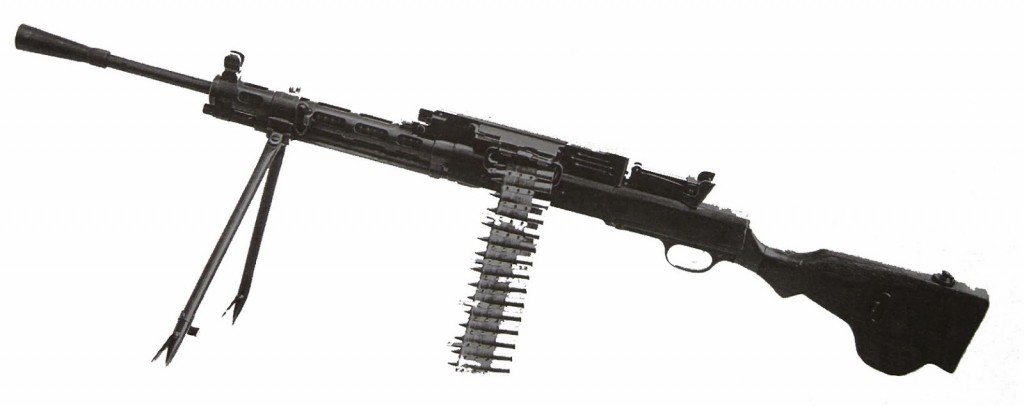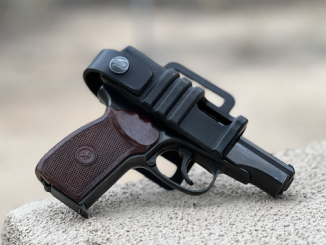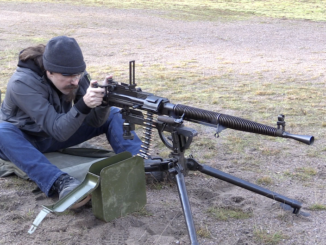From the Soviet Gun Archives blog, some photos of an experimental DPM-36 light machine gun (an improvement of the DP-28). Unfortunately, SGA does not list any source documents and my copy of Bolotin’s book doesn’t make any mention of these models, so I don’t have any additional information available beyond what can be deduced from the pictures.

This would be the standard version of the gun, with the obvious improvement of using box magazines instead of the more cumbersome to carry DP-28 pan mags. It also has a carry handle and finned barrel for improved cooling – and that barrel might well be detachable. Also, a pistol grip has been added (as was done on the formally adopted DPM). All things are tradeoffs, though, and while the box magazines are more convenient to carry they do also present a much larger target to the enemy, extending well above the gunner and gun (I have read accounts of Japanese LMGs in the Pacific being spotted by their magazines sticking up above the foliage).

This picture does not appear to be quite the same gun, although that doesn’t mean it wasn’t also a 1935 experimental idea. It seems to be very similar to the later RP-46 conversion, except probably made as a complete gun rather than a conversion that could lock in place of a pan magazine (there is no hook visible to operate off the bolt handle like the RP-46, suggesting that it runs internally). The belts in use here are also Maxim belts instead of the WWII-era metallic SG-43 belts. Other than that, the gun appears to be very similar to the standard DP-28.

Lastly, a purported paratroop version. It does have a shorter barrel and a bayonet lug, as well as a handgrip of some type affixed to the gas tube. The pistol grip of the first version above has reverted back to the more traditional stock design, albeit without the distinctive DP round hump on the bottom.
If anyone has more detail on these experimental variants, please let me know in the comments!




The standard DP already had a quickly detachable barrel, although usually only a single barrel was issued.
While much has been said about the awkwardness of the flat pan magazine, it nevertheless had a much higher capacity than any practical box magazine (57% higher than the 30 round magazine of the Bren, for example), and it was also very reliable.
Hmm, reliable? Err, no, not at all. Last week I had the opportunity to shoot a DP-28 with the reenacting guys. Our military contact organized the real DP with real LPS ball (the cross-dresser guys had their own blank-only eunuch and wanted to check it up against a real thing), while the reenactors rigged up the field to add some realism to a photo shoot. Guess what, the Dyegtarov didn’t liked all that flying debris one bit. And the pans proved the weakest link. Unfortunately, whoever designed that pan, apparently had no practical experience from where fast metal objects were flying. The upper part of the pan is set inside the lower one, so any sand landing on top tends to fall between the edges, the pans are screeching like hell with every turn, and as the top cover is also perforated to form the rake turning rounds inside, the sand goes there as well. Good thing, with all Soviet guns, they are not tight, so there’s plenty of room for the sand and debris – but to a point. Also, the edges of the platters are made of steel that lacks something in the hardness department: even in a sandy trench one pan falling from the parapet to the bottom of a standard trench – a fall of maybe 3 ft – got warped, and some sand, less than in a straight one, made it just stop in mid-burst. Of 10 pans in total, only three, all post-war manufacture with better screened top pan perforations have survived operational, my SA and 47 PATRON -stamped wartime originals were amongst the first to get stuck. After that exercise I got to realize why in early Soviet war films there are plenty of scenes showing LMG-gunner covering the DP with his own coat, the moment he quit shooting or something explodes nearby – perhaps either the actors themselves or the military advisors present at the scene had first-person knowledge just how long would the Patyefon (as DP were called) play that happy tune without such precautions. Then the knowledge disappeared and we now think DP was a good reliable LMG. Well, maybe for the Finnish: their alternative was the Lahti-Saloranta, or a glorified Chauchat…
Pictures
[sigh]
Pan magazines were ultimately another dead end. Sure, they didn’t require springs, but when it came to loading ammunition into the magazines, things got hairy fast. Even worse, storing the pans is not easy, especially if you’re talking about a tank-mounted DT (which was still pan-fed, and likely a bother for the main gunner).
As for the Lahti-Saloranta and the Chauchat, the former was too specialized (low capacity light machinegun) and complicated, and the latter was a potentially good idea sadly tied to substandard subcontractors (and a terrible magazine design).
“loading ammunition into the magazines, things got hairy fast.”
Soviets use Rakov device for speeding up loading:
https://www.forgottenweapons.com/rakov-dp-28-magazine-loader/
“if you’re talking about a tank-mounted DT (which was still pan-fed, and likely a bother for the main gunner)”
DA developed from DP and DT developed from DP machine gun use different magazine, holding 63 instead of 47, it was smaller in diameter but thicker. IIRC it was designed by Shpagin (PPSh and SPSh-2 designer).
Degtyarev in his memoirs (В.А.Дегтярев. Моя Жизнь. 1950) wrote that big challenge was designing the spent case-catching bag for DA, but when he saw movie with sportsmen in slow-mo, he found solution for this problem: determining spent case trajectory with high-speed camera. Anyway DA was soon phased out by ShKAS machine gun, which have bigger rate-of-fire even that twin DA machine gun. IIRC DT was also used by paratrooper, because it features telescoping stock, unlike fixed stock DP.
is: “twin DA machine gun”
should be (to be clear): “two DA machine gun linked together”
Handy bit of kit, as generally that is one of the down sides to pan mags like this the Lewis gun isn’t it- Reloading them.
So, what you basically saying is that it fails the highly relevant “shovel-load of sand on the magazine” test? The gun, including the magazine proved to be reliable under all weather conditions (from +35 to -30 degrees Celsius, rain, snow, etc.), something that was not necessarily true for the Maxim machine guns (especially with the original fabric belt). In fact Finnish soldiers found the DP resistant to small amount of sand (like you correctly point out) and it did not occur to them that it should be able to eat even larger amounts of sand.
Sand or soil ending up on the top of your LMG actually wasn’t quite as common occurrence as your re-enacting might suggest. When subjected to enemy artillery preparation, you should and would not be in the firing position but taking the best cover available (bunker, bottom of trench or foxhole, preferably with overhead cover, if not available behind large boulders, friendly vehicles etc.) with your weapon. If you stay in open firing positions (i.e. not in a bunker with overhead cover), you’re in a world of hurt anyways and getting dirt on your LMG is probably one of your smallest problems. If the dirt hits your weapon, the shell fragments will likely hit you, unless you are taking cover at the bottom of the trench or deep in an open foxhole WITH your weapon.
Also, the Finnish Army had a number (700) of FN D LMGs (in 8mm Mauser, no less), and while they were not issued to the same troops as the DP, I have never heard or read in any Finnish source that the DP was less reliable under combat conditions than the FN D.
Ok…would the comment about Japanese magazines apply equally to the BREN & VZ-26 ??
Yes. OTOH: The top mounted magazine allows the assistant gunner to rapidly accomplish mag changes, as opposed to the BAR’s short 20-round magazine mounted on the underside…
Yes, in fact the British complained bitterly about the “Bren Rattle” in which the Magazine being slightly loose would wobble back and forth as the bolt rode under it causing it to rattle and disturb any cover they had set up on top of it to disguise it.
In Georges “Shots Fired in Anger” he says that the British and Empire forces painted their Bren mags in camo but the Japanese did not camo their mags.
Hey, this is Brensky in disguise!
Isn’t the middle one the RP-46 machine gun?
Would be, with the addition of a vertical handgrip for the firing hand.
“If anyone has more detail on these experimental variants”
http://www.otvoyna.ru/pulemet.htm has some information:
“Дегтярев со своими помощниками много работал над модернизацией и усовершенствованием ДП. В 1936 году появляется модернизированный ДПМ-36, разработанный по типу чехословацкого ручного пулемета ZB-26. К его характерным особенностям относились: секторный магазин на 30 патронов, крепившийся сверху ствольной коробки, возвратно-боевая пружина, перенесенная в приклад, быстросменный ствол, а также два типа легких универсальных треножных станков конструкции И. Безрукова и И. Колесникова, позволявших превратить ДП и ДПМ-36 в станковый или зенитный пулемет. В том же году появляется еще один образец десантного ручного пулемета В.А. Дегтярева, отличавшийся от предыдущей модели запиранием одной боевой личинкой, рукояткой перезаряжания, выполненной в виде подствольного цевья, а также возможностью крепления клинкового штыка. Для проведения десантных операций к этому пулемету Дегтярев сконструировал легкий универсальный треножный станок очень простой конструкции с массой 7,5 кг.”
which mean:
Дегтярев and his workers were working on modernizing and improving DP. In 1936 DPM-36 appear, it was inspired by Czechoslovak ZB-26. It differs from DP: top-mounted box magazine for 30 cartridges, spring in stock, quick-change barrel, two types of tripod designed by И. Безруков and И. Колесников which allow DP or DPM-36 to be used as a mounted machine gun (станковый пулемёт) or AA defense MG.
In same year paratrooper version appear, it differs from DPM-36 in: having one locking lug, having a “pump” under barrel for reloading, and sword bayonet. Light 7,5-kg tripod was developed for this gun.
“If anyone has more detail on these experimental variants”
http://www.bratishka.ru/archiv/2010/5/2010_5_10.php describes DP and its variants, in Russian, I will translate only pictures description
From the top to bottom [my notes]
V. A. Degtyarev, 1940 years [badges: Order Of Lenin, Order Of The Red Star, ???]
7.62-mm tank machine gun DT mount on motorcycle
7.62-mm machine gun DP [in transport mode – see flash hider]
Kovrov plants, V. A. Degtyarev and workers of plant
7.62-mm light paratrooper Degtyarev machine gun RPD-36 (РПД-36), experimental model, 1936 year, on universal Degtyarev tripod (for AA fire)
7.62-mm light DP machine gun, on universal tripod (for ground fire)
7.62-mm quadruple tank machine gun DTM-4 (ДТМ-4). Experimental model, 1939 year.
Internet translations are sometimes dubious aren’t they, although there’s perhaps some difficultly in providing a direct transliteration “The bore is locked by tilting gate in the vertical plane” i.e. A tilting breechblock, for example.
Original: В 1943 году появляются несколько опытных образцов ручных пулеметов Дегтярева, изготовленных методом штамповки и точечной сварки. Запирание канала ствола осуществлялось перекосом затвора в вертикальной плоскости. К одной из основных особенностей этих пулеметов относилась новая система быстрой смены ствола, разработанная В. И. Симониным. Еще в 1942,
Translated: In 1943, there are a few prototypes Degtyarev light machine guns manufactured by stamping and spot welding. The bore is locked by tilting gate in the vertical plane. For one of the main features of these guns belonged new quick-change barrel system developed by VI Simonini. Even in 1942,
I may have learnt some Russian, B means In, I think.
I used an internet translator on another Russian webpage once and it said the Lada truck went into warp speed which I found hard to believe, if I remember correctly.
“Lada truck went into warp speed”
Now that is something I would pay to see!
The ability of Internet translators to deform is unbeliveable, just see:
http://justsomething.co/34-hilarious-translation-fails/
for examples.
“I may have learnt some Russian”
Do you know Russian alphabet now?
“VI Simonini”
Should be: V.I. not VI, explanation: In Russian you don’t only use name and surname but name – отчество – surname, отчество is derived from father’s name, so for example Vasily Alekseyevich Degtyaryov mean Vasily Degtyaryov son of Aleksey, hence Russians always have two letters before surname.
B does mean In, and is pronounced V apparently… I get the impression learning Russian might be quite difficult, how can one letter make two i.e. B for I and N which you say as vee, mind you vee sounds Russian “vee the kitchen I have cooker da” 🙂
Dp’s are flapper locked, they don’t use tilting bolts, how do you say flapper locked in Russian?
Thanks!
That bottom gun is a Berthier. The handle on the gas tube is the cocking handle. Note also the side ejection port. See U. S. Patents 1,083,872 and 1,366,863.
Talking about translation issues, it came to my mind that a long list of insanely funny stuff with 140 photos about wrong Chinese>English translations. Check out the https://www.actranslation.com/knowledge/fun/hilarious-translations.htm and I think you just won’t be able to stop your laughter.